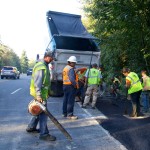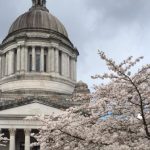Like many advocates for safer streets and healthy communities, we at Washington Bikes were dismayed when Congress cut funding and eliminated dedicated programs for walking and biking in the two-year federal transportation funding bill signed into law this July.
To recap, the new federal transportation bill, Moving Ahead for Progress in the 21st Century (MAP-21) as its authors call it, diminishes direct funding for walking and biking by a minimum of 35%. Those dramatic cuts could skyrocket to 70%, if state leaders exercise opt-out options to divert funding elsewhere.
For Washington state, the ramifications of MAP-21 were clear: progress in growing investments for a popular and oversubscribed Safe Routes to School program was at risk, overall funding from the state’s two biking and walking grant programs would be cut, and last year’s legislative victories to garner a larger state commitment for Safe Routes to School would be nullified by the reduction in federal investments.
To add to the challenge, the Washington Department of Transportation (WSDOT) quickly proposed distributing the state’s allocation of Transportation Alternatives (TA) program monies, including those previously allocated to Safe Routes to School, to the local level.
The WSDOT proposal represented a one step forward, two steps back approach for walking and biking. In Washington state we are lucky that federal money sent to the Spokane Regional Transportation Council, Puget Sound Regional Council, and other regional planning organizations often leads to investments for biking and walking, but in this context it would likely end most federal Safe Routes to School investments since many local governments lack the know-how or experience to fund these projects.
As the October 1 deadline approached for states to decide how to allocate new federal transportation funding, Governor Christine Gregoire convened an advisory stakeholder committee made up of varied transportation interests. Unfortunately, walking and biking interests did not get a seat at the table.
Charging into the uphill battle, we collaborated with our state allies at the Transportation for Washington Campaign, and nationally at the Safe Routes to School National Partnership, Advocacy Advance, and America Bikes to learn more about MAP-21 and other states’ strategies. We spoke to stakeholders on the committee, heard their input, and made the case for continued federal investments in Safe Routes to School.
Quickly a strategy emerged: Use Highway Safety Improvement Program (HSIP) funding – slated to almost double under MAP-21 – as a new source. It made sense: 14% of all serious injuries and deaths in Washington occur when walking or biking and yet HSIP funds expend less than 1% to fix this problem. Similarly, walking on Washington state streets constitutes the third leading cause of death for our kids.
Over the course of the governor’s steering committee meetings, passionate testimony from advocates, parents, and experts highlighted the need for continued federal money for Safe Routes to School. At the first meeting, Washington Bikes board member King Cushman, who served on a similar state steering committee in the 1990s, noted that cost-effective investments for walking and biking made sense for the state’s fiscal bottom line, as well as for the safety of our state’s children.
Despite opposition from some at WSDOT, legislators and other stakeholders around the table saw the nexus between Safe Routes to School and HSIP. Our outreach to state leaders effectively outlined that their choice could help or hurt kids’ safety. At those meetings a majority of steering committee members expressed their interest to continue federal investments in Safe Routes to School. Elected leaders like House Transportation Committee Chair Judy Clibborn voiced strong support for Safe Routes to School. Senate Transportation Committee Chair Mary Margaret Haugen noted the importance of linking Safe Routes to School to the Highway Safety improvement Program and smartly observed that Safe Routes to School are a rural safety issue, as well.
We are proud that these leaders made the right choice for Washington’s kids.
As a result, the MAP-21 letter to the Governor recommends funding the Safe Routes to School grant program will at the same dollar level as in 2009 (this $3.3 million is actually more than was funded in 2011) by providing one-third of federal funds from HSIP and two-thirds from TA and we have established a critical policy nexus connecting biking and walking to road safety dollars.
 As the Washington state strategic highway safety plan update commences in 2013 the Bicycle Alliance will continue to highlight the lack of safety investments for those that bike and walk.
As the Washington state strategic highway safety plan update commences in 2013 the Bicycle Alliance will continue to highlight the lack of safety investments for those that bike and walk.
The Bicycle Alliance will continue to engage stakeholders as the lead point of contact for the bicycling community on MAP-21 implementation. We foresee future challenges and opportunities as we work to expand recognition of bicycling as a critical element of transportation worthy of investment. With MAP-21 a great deal of the action has moved to the state level, making our role as the statewide bicycle advocacy organization more critical than ever. The success stories we can tell as we improve infrastructure and safety and grow bicycling statewide will then help our friends in national organizations make the case for the next federal transportation bill to do much more to enhance bicycling and walking across the nation.




One Comment
Blake, thank you for the comprehensive description of the work behind re-funding Safe Routes to School programs. You and King are effective spokesmen for bicycling in Washington State.